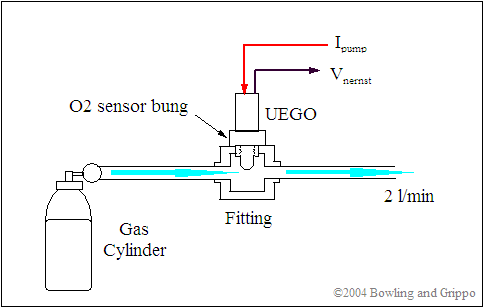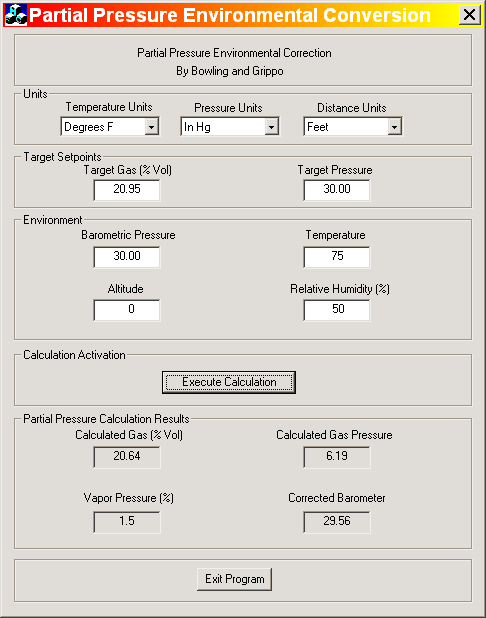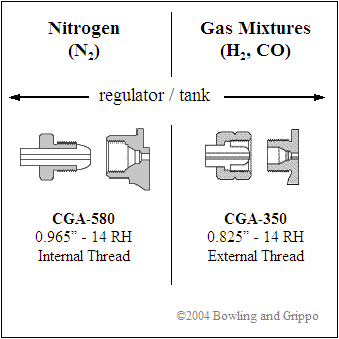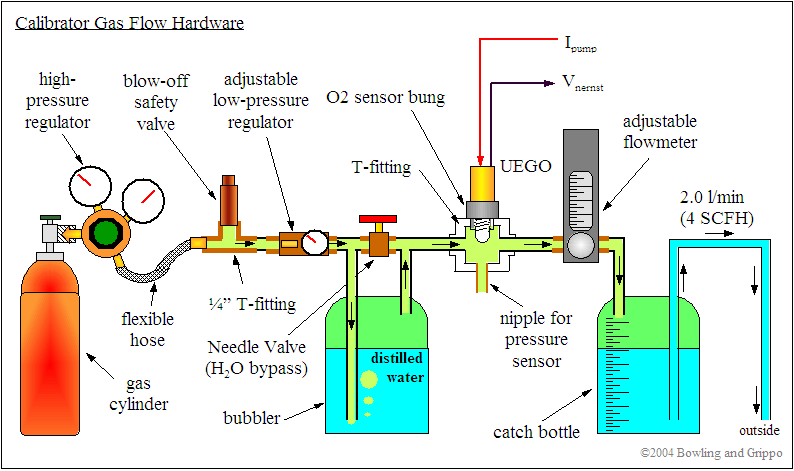 |
 |
Calibration of the wideband UEGO sensors is relatively easy, but it requires a known precision gas of certain mixtures. You will want a set of gas mixtures that allow you to make lean, rich, and stoichiometric measurements. The actual flow bench is pretty simple to build (see below). Then you just squirt some test gas over the sensor as shown in the following illustration:

There really is not much more to it than this, in principle. You must obtain a mixture of test gas, and regulate the flow down to approximately 2 liters per minute, or 4 standard cubic feet per hour (SCFH), at the desired pressure. Using a tee fitting arrangement, pass the gas over the sensor.
To get the diffusion constant, set the pump current (Ipump) so that the Nernst cell voltage (VS) is equal to 0.45 volts. The pump current (Ipump) corresponds to the diffusion constant for the partial pressure of gas in the cylinder.
An alternative fitting arrangement for the “tee” is an “end-tube” sort of arrangement:

Either sensor flow mounting method works for determining the coefficients.
Now for the gas mixtures. For the lean side, it is very easy. You can use atmospheric air (with the partial pressure of oxygen corrected by barometer/humidity/altitude), or even supply it with a small air compressor set to yield the desirable flow rate of 2 litres/minute (4 SCFH).
For the stoichiometric point, nitrogen (N2) at a concentration of at least 99.999% should be used. In order to provide oxygen donors to the mix, either mix in 2% or so of CO2, or pass the N2 gas through a washing bottle "bubbler", which is just a flask or similar with distilled water where the N2 gas has to bubble through – this will introduce a small amount of water vapor in the mixture.
For the rich side, the sensor reacts to CO, H2, and H C
C . We need to test the sensor for each of these three gas species in order to obtain the diffusion coefficient.
. We need to test the sensor for each of these three gas species in order to obtain the diffusion coefficient.
All of these gases can be nasty to work with and pose a significant oxygen deficiency hazard, so be sure there is sufficient ventilation for the escaping gas. The mixtures can also explode - they are extremely flammable. Be very careful! You should keep a self-contained breathing apparatus setup around in case it is needed in emergency. We have warned you, and have included the “bad” symbol to back it up:

There are a number of safety procedures you MUST follow regarding the gases, the regulator, and the other equipment.
For the mixtures, pick a percent mix (by weight) that is roughly 5 – 10% of CO or H2, and fill the remainder with N2.
| CO | Carbon Monoxide - 10% by weight, 2% CO21, 88% N2 |
| H2 | Hydrogen - 10% by weight, 2% CO22, 88% N2 |
| HC | Hydrocarbon (can use high quality propane - C3H8 or acetylene - C2H2) |
| N2 | Nitrogen, 99.999% pure + 2% CO23 |
| Air | Must correct for barometric pressure/humidity/altitude |
These setups require frequent re-calibration (on order of every half hour or so, depending on the test apparatus). As a result, there are BAR-certified gas blends available that are used to calibrate the gas analyzers.
These gas blends, which are 2% relative accurate, are manufactured in cylinders from BAR-certified gas blenders. These cylinders are pretty much the same – 12.74 liters of blend gas at 300 psi in a non-refillable (i.e. throw-away) UEGO cylinder with a valve with a 45° flare fitting.
Note: these cylinders will require a regulator or some sort of orifice (like a Whitey or Nupro metering valve) so that you do not blow yourself up with 2200+ psi of gas pressure. Do not use without a regulating or restrictive device, period. Once again, the “bad” symbol:

There are different BAR-certified gas blends available – here is a table of the different blends:
| Propane (HC) | 1200 | 3200 | 300 | 200 | ppm |
| CO | 4.00 | 8.00 | 1.00 | 0.50 | Percent Weight |
| CO2 | 12.00 | 12.00 | 6.00 | 6.00 | Percent Weight |
| NO | 0 | 3000 | 0 | 300 | ppm |
| O2 | 0 | 0 | 0 | 0 | Percent Weight |
The problems with BAR gas blends are that:
Finally, for calibrating the lean side of things, i.e. the excess oxygen situation, one can use free air. That is use air at atmospheric pressure. Atmospheric air at sea level has roughly 21 percent oxygen (partial pressure) so this can be used for calibration. However, altitude and vapor pressure will affect the partial pressure component, so these need to be accounted for in the calibration. B&G has developed a Windows application that computes the required correction such that one can use atmospheric oxygen readings for calibration.

Here is the link for the application and the documentation:
Obtaining the Gases
To calibrate the sensor, you need a number of gases (the gas we are interested in is called the "minor component", the gas it is mixed in is called the "balance gas"). These gases can be purchased from compressed gas suppliers.
| Minor Component | Balance Gas | Typical Cost* Size A cylinder |
| CO** - Carbon Monoxide - 10% by weight | 2% CO21, 88% N2 | ~$141 |
| H2** - Hydrogen - 10% by weight | 2% CO22, 88% N2 | ~$191 |
| HC - Hydrocarbon (can use high quality propane*** - C3H8 or acetylene - C2H2) | 99.5% Pure | ~$254 |
| N2 - Nitrogen****, 99.9993% pure | 2% CO23 | ~$132 |
| Air | Must correct for barometric pressure/humidity/altitude | free! |
1,2,3 Note that the 2% CO2 is not needed if using a bubbler. The CO2 is NOT included in the above mix prices.
* Includes gas only, tank rental/purchase is extra.
** Certified Master Class from Scott Specialty Gases, traceable to NIST, ±2%.
*** Specs/price for Instrument Grade Propane, 99.5% Pure (Liquid Phase)
**** Pure Grade (TechniPure™ for Pure Gas Applications), < 10 ppm contamination
The gases will most likely have to be made up as a special order. They have to weigh the gas and it takes a few hour to fill the bottles, and of that mix what does not get put into your cylinder gets vented as waste gas - and they tend to charge you for the entire mix. So, the larger the cylinder you can get the better.
You can purchase specialty gases from sources such as Airgas® or Scott Specialty Gases. You will also need a washing bottle bubbler or other means of introducing a few percent of H2O or CO2, like before.
If you cannot get gas bottles with a little CO2 or H2O to provide the O2 donors, then you can put in a wash bottle bubbler. This is basically a bottle with distilled water where the gas has to flow through the water before hitting the sensor. This just puts a little water vapor into the mixture, to provide enough species for the donors.
Alternatively, when you get the gases mixed, just have them add a little CO2 (~2%), and ~10% of the test gas (either H2 or CO), and the rest filled with N2. When they mix up the bottles, have them do the mixing by weight.
For the hydrocarbon (H C
C ), it gets a little tougher. One can flow propane - C3H8 - (of good quality) to get a feel for the magnitude of the coefficient. As before you will need a washing bottle.
), it gets a little tougher. One can flow propane - C3H8 - (of good quality) to get a feel for the magnitude of the coefficient. As before you will need a washing bottle.
For the gas mixtures, try to obtain Primary Gas standards, which are ±1% relative purity or ±0.002% absolute purity. Primary gas is “traceable to NIST standards” and will indicate this on the bottle. (NIST is the National Institute of Standards and Technology.) If this becomes too expensive, then a Certified Gas standard can be used in place. Expect to pay several hundred dollars for all of the gas mixtures – it is not cheap.
Before ordering your calibration gases, you will need to decide how much you will be using. The following are some common cylinder sizes (for North America):
| Cylinder Designation | Diameter x Height -including valve & cap- (inches) | Weight lbs (kg) | Volume @ 1atm. liters (cu.ft.) | DOT Spec. | ||
| K | 9¼" x 60" | 135 (61) | 50 (1.76) | 3AA2400 | ||
| A | 9" x 56" | 114 (52) | 44 (1.55) | 3AA2015 | ||
| B | 8½" x 31" | 60 (27) | 17 (0.61) | 3AA2015 | ||
| C | 6 x 24" | 27 (12) | 7 (0.24) | 3AA2015 | ||
| D | 4" x 18" | 12 (5½) | 2 (0.08) | 3AA2015 | ||
| AL | 8" x 53" | 52 (23½) | 30 (1.04) | 3AL2015 | ||
| BL | 7¼" x 39" | 33 (15) | 16 (0.55) | 3AL2216 | ||
| CL | 7¼" x 21" | 19 (8½) | 6 (0.21) | 3AL2216 | ||
| XL | 14½" x 50" | 75 (34) | 108 (3.83) | 4BA240 | ||
| XXB | 8" x 37" | 95 (43) | 19 (0.67) | 3A1800 | ||
| 10 S | 4" x 31" | 21 (9½) | 4 (0.13) | 3A1800 | ||
| LB | 2" x 15" | 4 (2) | ½ (0.02) | 3E1800 | ||
| XF | 12" x 46" | 180 (82) | 61 (2.15) | 8AL | ||
| XG | 15" x 56" | 149 (68) | 126 (4.46) | 4AA480 | ||
| XM | 10" x 49" | 90 (41) | 54 (1.92) | 3A480 | ||
| XP | 10" x 55" | 55 (25) | 56 (1.98) | 4BA300 | ||
Nitrogen (N2), hydrogen (H2), and carbon monoxide (CO) are commonly available as compressed gas in cylinders. Nitrogen is sold pure, and hydrogen and carbon monoixde are available as specified components (with the rest a "balance gas", nitrogen, in our case.)
In North America, the principal suppliers of compressed gasses are:
Look in your local phone book under the headings "compressed gas suppliers", "gasses", or "welding supplies". Other gas sources may be automotive supply houses, university research departments, vocational/technical schools, and medical supply houses.
Nitrogen is generally available in a number of forms ranging from gas intended for welding, to various "purity assured" levels, to gas mixtures where N2 would merely be one of the components (such as the CO and N2 mixes we desire).
Note that welding nitrogen is essentially a pure gas, but it has one important difference. Nitrogen used for welding has the possibility that some form of contaminating gas may have been in the cylinder from a previous user. This could happen if the tank was being used in an application where the N2 cylinder's internal pressure fell low enough for pressure from the intended target to reverse into the N2 cylinder. Perhaps the tank may have been pressurized using ordinary compressed service air. The most likely contaminants in the tank will be moisture, carbon monoxide, carbon dioxide, oxygen, and hydrocarbons, but there is the remote possibility of something even more exotic or toxic getting into your cylinder. Not all welding gas cylinders are checked by the gas supplier before being refilled and sent back out for use. The possibility of unknown contamination generally prohibits the use of welding grade nitrogen for calibration. If your supplier will certify that welding gas cylinders are checked before refilling, they should be useable.
The various "purity assured" nitrogen gases are somewhat more difficult to find, and cost slightly more. However, this is more than made up for by the fact you know exactly what is in the tank. Air Liquide, as an example, offers seven types of purity assured nitrogen (N2) ranging from 99.995% to 99.9995% pure, with none of them having a water vapor content greater than 1 part per million (ppm), or an oxygen content over 3 parts per million (ppm). Any of these are suitable for calibrating the WB02/PWC, so the most inexpensive form is all you need.
As you might expect, compressed gas cylinders come in a number of different sizes. Using Air Liquide as an example, sizes 44 and 49 cylinders are the most common. There are other cylinder sizes of smaller physical dimensions and capacities. However, the logistics of compressed gas production and transport being what they are, they may cost as much, or even more, than the larger more common sizes. The actual gas inside the cylinder is relatively cheap, but moving the heavy cylinders around is not.
| Cylinder Size | Capacity Cu Ft | Filled PSIG | Weight Pounds | Height Inches | Diameter Inches |
| 44HH | 445 | 6000 | 339 | 51 | 10 |
| 44H | 332 | 3500 | 225 | 51 | 10 |
| 49 | 304 | 2640 | 165 | 55 | 9¼ |
| 44 | 234 | 2265 | 149 | 51 | 9 |
| 16 | 77 | 2000 | 71 | 32½ | 7 |
| The "H" suffix means high pressure.
PSIG = Pounds per Square Inch on the Gauge. | |||||
Unfortunately, different suppliers uses differing designations for the various cylinder sizes.
| Air Liquide | Airco | Air Products | Linde | Liquid Carbonic | Matheson | MG Industries | Scott |
| 49 | 300 | A | T | J | 1L | 300 | K |
| 44L | 200 | - | K | H | 1A | 200 | A |
| 44 | 200 | B | - | - | - | - | - |
| 44H | - | BY | 3K | - | 1H | 2HP | - |
| 44HH | 500 | BX | 6K | - | 1U | 3HP | - |
| 16 | 80 | C | Q | M | 2 | 80 | B |
The size 49 cylinder from Air Liquide has an equivalent from all the suppliers. This size is commonly used to fill helium balloons at county fairs, ball games, etc.
While you can purchase a cylinder, it may be less expensive to rent a cylinder from the gas supplier. They will generally require you to fill out an application, pay a refundable cylinder deposit and buy the gas contained in the cylinder. Tank rental periods vary, however a common rental period is 30 days.
There are numerous safety considerations and precautions when handling compressed gas cylinders.
Delivery by the supplier can often be arranged, or they might help you load the cylinder into your vehicle. The preferred method of transportation is for the cylinder to be restrained with a chain, clamp or otherwise solidly secured in a vertical position with the cylinder cap in place. Transportation regulations vary by city, state, and country. You should inquire with your gas supplier to find a safe and legal means of moving the tank.
The only thing that will come with your cylinder is the cylinder cap. This is an important safety device, and it should always be in place when the cylinder is not is use. All of the common cylinder sizes will use the Compressed Gas Assembly (CGA) (CGA) cylinder fittings. The downstream side of these fittings can be obtained with different threads, but a ¼" NPT (National Pipe Thread) nipple is normally needed to mate with the regulator body (see below).
Gas mixtures usually come with a CGA-350 fitting, and pure nitrogen usually comes with a CGA-580 fitting.

The CGA fittings come in a variety of metals such as carbon steel, stainless steel, and brass. The best choice for the CGA fitting is a metal that matches the metal of the regulator or orifice (like a Whitey or Nupro metering valve). If the CGA fitting and regulator are to be used only with dry, non-oxygen containing gasses, in a dry environment then galvanic corrosion can be disregarded so the most inexpensive metal composition can be used even if it is not the same as the regulator. If the tank is to be used in a wet area, or with oxygen containing gasses then matching metal composition becomes very important.
When the tank is to be returned, there must be some residual pressure left in the cylinder or you may have to pay a surcharge (or lose your deposit). This is especially true of "purity assured" gasses, since the residual gas will have to be analyzed for the safety of all cylinder users.
The Calibrator Hardware
The calibrator hardware consists of a number of gas flow devices, and an optional automated data acquisition unit (the LabJack).

A major expense in using compressed gases is the equipment needed to safely handle and control it. Unless you can borrow the appropriate equipment, it will have to be purchased, new or used. Even the cheapest regulators and gauges are not inexpensive. Orifice style metering valves, like a Whitey or Nupro metering valve, can be cheaper than regulators.
You may be tempted to not use a regulator or orifice (like a Whitey or Nupro metering valve), but FOR YOUR OWN SAFETY, USE A REGULATING OR RESTRICTING DEVICE. A full cylinder of compressed gas may have an internal pressure of 2200 PSIG or more; many, many times normal atmospheric pressure. If the cylinder valve was opened only slightly too far a great deal of very high pressure gas will flow and there is a real potential for serious injury.
For your safety, get the necessary equipment. If you purchase your own regulator/gauge cluster and/or your own cylinder, you must perform periodic maintenance:
Note that you can use a needle valve, in the input side, as an adjustable regulator. You can use a Nupro valve, but a Swagelok or Whitey or something similar will work fine. eBay has these all the time. This is not an absolute requirement, but it may make life easier, and is cheaper than a high and low pressure regulator arrangement (although not as controllable or repeatable).
The gas flow hardware shown in the diagram above includes:
Note that all the components downstream of the low pressure regulator (including the bubbler and catch tank) must be capable of withstanding any test pressure you plan to use. Components between the low pressure and high pressure regulators must be capable of withstanding at least the blow-off valve pressure setting. The high pressure regulator must be capable of handling up to 3000+ psi.
| 1 | 7897A65 | Single Stage Nitrogen Regulator, CGA-580, ¼" NPT fittings for gas lines | $82.55 |
| 1 | 5079K65 | Polycarbonate Panel Mount Flowmeter, 1-11 SCFM, with Valve | $39.39 |
| 1 | 7833K49 | Miniature Medium-Pressure Needle Valve Carbon Steel, 1/4" NPT Female X Female | $19.00 |
| 1 | 50265K23 | Brass Multi-Pressure Range Pop-Safety Valve Soft-Seated, 1/4" NPT Male, 25-200 Psi | $3.45 |
| 1 | 45525K641 | Stainless Steel Threaded Pipe Fitting 1/4" X 1/8" Pipe Size, Female Reducing Coupling | $3.10 |
| 1 | 9892K122 | Mini Regulator 1/4" NPT Female Inlet, 1/4" Male Outlet, 5-50 PSI | $21.42 |
| 1 | 9891K66 | Mini Regulator Mounting Bracket | $2.24 |
| 0 | 79215A664* | Regulator Fitting, Male Thread Inlet Nut, CGA #580* (included with regulator above) | $2.33 |
| 0 | 79215A665* | Regulator Fitting, Inlet Nipple, CGA #580* (included with regulator above) | $2.21 |
| 1 | 79215A666* | Regulator Fitting, Female Thread Inlet Nut, CGA #350* | $2.47 |
| 1 | 79215A667* | Regulator Fitting, Inlet Nipple, CGA #350* | $2.77 |
| 3 | 4978K122 | Bronze Threaded Pipe Tee Fitting, 1/4" Pipe | $3.46 |
| 1 | 4548K112 | 304/304L SS Pipe Nipple - Schedule 40 - 1/8" Pipe, 1.5" Length | $1.57 |
| 6 | 4548K132 | 304/304L SS Pipe Nipple - Schedule 40 - 1/4" Pipe, 1.5" Length | $1.68 |
| 1 | 91465K11 | Push-On Brass Hose Fitting Barbed X Male For 1/4" Hose ID, 1/8" Pipe Size, Packs of 10 | $6.18 |
| 1 | 91465K91 | Push-On Brass Hose Fitting Barbed X Male For 1/4" - Hose ID, 1/4" Pipe Size, Packs of 10 | $7.05 |
| 1 | 5680K61 | Hi-Pressure (1800 psi) Flexible 321 SS Braided Hose Assembly, 1/4" ID, W/ ¼" NPT Male Couplings, 36" Long | $26.14 |
In general, regulators are designed to match a specific gas or gases. However, if you want to change your existing regulator fitting to match your tank, you can use the following nuts and nipples on your regulator (these have a ¼" NPT thread):
| Gas | CGA # | Nut | Nipple | Price (ea.) | Price (ea.) |
| Carbon Dioxide (CO2) | 320 | 79215A653 | 79215A654 | $1.78 | $2.79 |
| 346 | 79215A655 | 79215A656 | $2.22 | $2.63 | |
| Mixed Gases | 350 | 79215A666 | 79215A667 | $2.47 | $2.77 |
| 510 | 79215A657 | 79215A658 | $1.95 | $2.23 | |
| Acetylene (C2H2) | 520 | 79215A659 | 79215A661 | $2.28 | $3.08 |
| Oxygen (O2) | 540 | 79215A662 | 79215A663 | $1.83 | $2.02 |
| Nitrogen (N2) (& other inert gases) | 580 | 79215A664 | 79215A665 | $2.33 | $2.21 |
If you don't want to change your regulator fitting, McMaster-Carr sells the following adapters:
The LabJack U12 U12 Measurement and Automation Peripheral
If you are planning to calibrate a number of sensors, you may be able to automate the measurement part by using a MAP sensor hooked to a DAQ (data aquisition) system. The LabJack U12 has a differential voltage measurement mode (recall that the O2 sensor output is a differential voltage between the reference cell and the Nernst cell), among many other features.
The LabJack U12 is a measurement and automation peripheral that enables the connection of a PC to the real world.
So, you could use a power supply (at 5 volts) in series with a resistor (for the current measurement), with this resistor hooked across the LabJack U12 in differential measurement mode, and another adjustable resistor in series, and use this to provide adjustable pump current.
The output of the Nernst can be fed right into the LabJack U12. So, you do not need a wideband meter to generate calibration curves, just feed in your own voltages. Additionally, you can generate a family of curves of Nernst output vs. pump current for different test gases - this is good data for setting up the pump/nernst feedback loop.
Although the LabJack U12 has many redundant protection mechanisms, it is possible, in the case of improper and/or unreasonable use, to damage the LabJack and even the PC to which it is connected.
The external features of the LabJack U12 include:
For the complete LabJack U12 User’s Guide or the latest version of the LabJack software, go to www.labjack.com.
* We dedicate the Precision Wideband Controller to the memory of Garfield Willis. Garfield was instrumental in early research and development of the EGOR wideband controller.